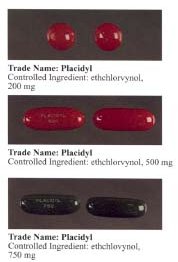Ethchlorvynol
Overview of the sedative and hypnotic drug Ethchlorvynol
Ethchlorvynol[edit]

Ethchlorvynol is a sedative and hypnotic medication that was primarily used for the treatment of insomnia. It was first introduced in the 1950s and marketed under the brand name Placidyl. Ethchlorvynol is a member of the pyrrolidine class of drugs and acts as a central nervous system depressant.
Pharmacology[edit]
Ethchlorvynol works by enhancing the activity of the neurotransmitter gamma-aminobutyric acid (GABA) in the brain, which results in sedative and hypnotic effects. It is known to have a rapid onset of action, typically within 15 to 30 minutes, and its effects can last for several hours. The drug is metabolized in the liver and excreted by the kidneys.
Medical Uses[edit]
Ethchlorvynol was primarily prescribed for the short-term management of insomnia, particularly in patients who had difficulty falling asleep. It was also occasionally used as a pre-anesthetic medication due to its sedative properties.
Side Effects[edit]
Common side effects of ethchlorvynol include drowsiness, dizziness, headache, and nausea. In some cases, it can cause paradoxical reactions such as agitation or excitement. Long-term use can lead to tolerance, dependence, and withdrawal symptoms upon discontinuation.
Synthesis[edit]

The synthesis of ethchlorvynol involves the reaction of propargyl alcohol with trichloroethylene in the presence of a base to form the ethchlorvynol compound. This process highlights the chemical transformation necessary to produce the active sedative agent.
Regulation and Discontinuation[edit]
Due to concerns about its safety profile, including the risk of overdose and abuse, ethchlorvynol was gradually phased out in many countries. In the United States, the manufacturer discontinued its production in 1999, and it is no longer available for prescription.
Related Pages[edit]
Ad. Transform your life with W8MD's Budget GLP-1 injections from $75


W8MD offers a medical weight loss program to lose weight in Philadelphia. Our physician-supervised medical weight loss provides:
- Weight loss injections in NYC (generic and brand names):
- Zepbound / Mounjaro, Wegovy / Ozempic, Saxenda
- Most insurances accepted or discounted self-pay rates. We will obtain insurance prior authorizations if needed.
- Generic GLP1 weight loss injections from $75 for the starting dose.
- Also offer prescription weight loss medications including Phentermine, Qsymia, Diethylpropion, Contrave etc.
NYC weight loss doctor appointmentsNYC weight loss doctor appointments
Start your NYC weight loss journey today at our NYC medical weight loss and Philadelphia medical weight loss clinics.
- Call 718-946-5500 to lose weight in NYC or for medical weight loss in Philadelphia 215-676-2334.
- Tags:NYC medical weight loss, Philadelphia lose weight Zepbound NYC, Budget GLP1 weight loss injections, Wegovy Philadelphia, Wegovy NYC, Philadelphia medical weight loss, Brookly weight loss and Wegovy NYC
|
WikiMD's Wellness Encyclopedia |
| Let Food Be Thy Medicine Medicine Thy Food - Hippocrates |
Medical Disclaimer: WikiMD is not a substitute for professional medical advice. The information on WikiMD is provided as an information resource only, may be incorrect, outdated or misleading, and is not to be used or relied on for any diagnostic or treatment purposes. Please consult your health care provider before making any healthcare decisions or for guidance about a specific medical condition. WikiMD expressly disclaims responsibility, and shall have no liability, for any damages, loss, injury, or liability whatsoever suffered as a result of your reliance on the information contained in this site. By visiting this site you agree to the foregoing terms and conditions, which may from time to time be changed or supplemented by WikiMD. If you do not agree to the foregoing terms and conditions, you should not enter or use this site. See full disclaimer.
Credits:Most images are courtesy of Wikimedia commons, and templates, categories Wikipedia, licensed under CC BY SA or similar.
Translate this page: - East Asian
中文,
日本,
한국어,
South Asian
हिन्दी,
தமிழ்,
తెలుగు,
Urdu,
ಕನ್ನಡ,
Southeast Asian
Indonesian,
Vietnamese,
Thai,
မြန်မာဘာသာ,
বাংলা
European
español,
Deutsch,
français,
Greek,
português do Brasil,
polski,
română,
русский,
Nederlands,
norsk,
svenska,
suomi,
Italian
Middle Eastern & African
عربى,
Turkish,
Persian,
Hebrew,
Afrikaans,
isiZulu,
Kiswahili,
Other
Bulgarian,
Hungarian,
Czech,
Swedish,
മലയാളം,
मराठी,
ਪੰਜਾਬੀ,
ગુજરાતી,
Portuguese,
Ukrainian